
Have you ever imagined shopping on a boat surrounded by vivid colors, energetic merchants, and the aroma of mouthwatering street cuisine floating around? Welcome to Bangkok floating markets—a magic place! These vibrant markets, floating around the canals of Bangkok, are a special fusion of adventure, history, and culture. Whether your vacation to Bangkok is first-time or seasoned, seeing a floating market is very essential.
But just what are Bangkok’s floating markets exactly? Which ones should you tour and how do you visit them? We’ll address these concerns and more in this guide, providing a thorough view of Bangkok’s floating markets, what makes them unique, and how best to maximize your trip. There is a floating market for every taste from the busy Damnoen Saduak market to the more tranquil Amphawa and Taling Chan.

Consider this: Surrounded by vibrant boats offering tropical fruits, beautiful flowers, homemade crafts, and sizzling street cuisine, you are floating over the river on a little boat. As friendly sellers present their offerings, the air is filled with conversation. Greetings in Bangkok’s floating market!
A floating market is a conventional market set up from boats. In Thailand, where rivers and canals previously dominated commerce and mobility, this idea has been around for millennia. Bangkok’s floating markets nowadays are not only a major tourist destination but also a magnet for local business. Still, what distinguishes these markets?
Floating Markets’ Cultural Value
The floating market offers a window into Thai culture, not just a location to find mementos. In Thailand, historically the rivers were vital for trade and movement. Vendors would arrange their boats to market their fresh fish, commodities, and veggies. These floating marketplaces capture the way of life of past Thai people, in which the lifeblood of the economy was rivers and canals.

Seeing a floating market is akin to traveling back in time to a world in which river-based communal life dominated and trade was done on the water. Though they have developed to combine the old and the modern and serve both residents and visitors, floating markets today still have the same appeal.
Bangkok Floating Markets: What Might You Find?
A floating market is sensory feast on demand. Boats bursting with fresh fruit like coconuts, mangoes, and pineapples will be seen as you paddle over the rivers. Right before your eyes, you may also discover Thai delights such boat noodles, grilled fish, and Thai-style coffee presented in little cups.

From traditional Thai clothes and fabrics to complex wooden sculptures and handcrafted jewelry, the markets also provide a great range of artisan goods. One may get lovely mementos reflecting Thai rich culture here.
Top Floating Markets Bangkok Worth Seeing
Should you want to visit Bangkok’s floating market, you are in for a treat. With so many to choose from, however, how can you decide which one suits you? The top Bangkok floating markets, all providing a different experience, are broken down here.
Floating Market of Damnoen Saduak
For first-time visitors, Damnoen Saduak—arguably the most well-known floating market in Bangkok—must be seen. Often the first market that springs to mind when one considers Bangkok floating markets, it is about 100 kilometers southwest of the capital.
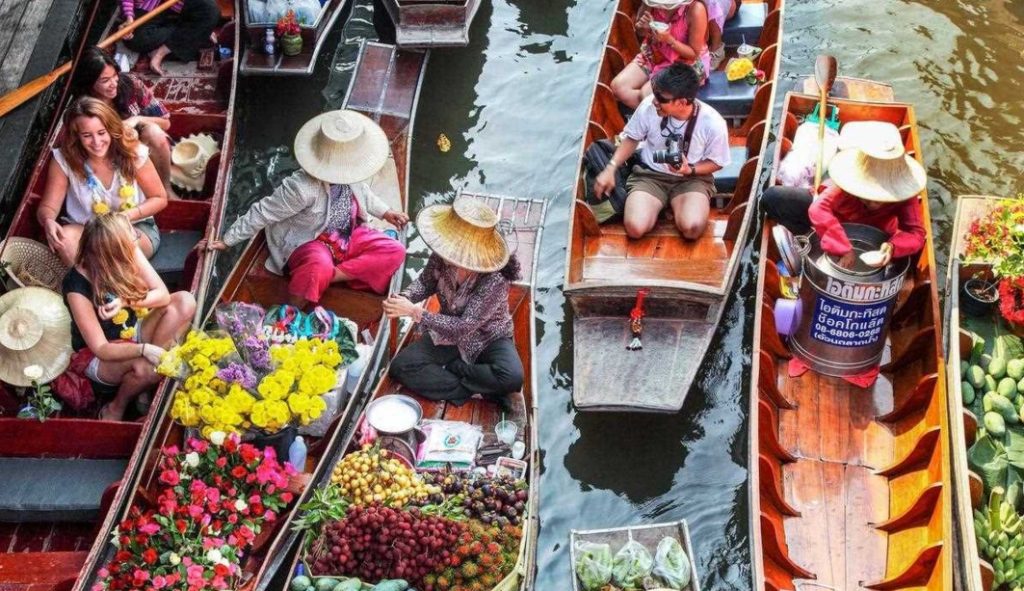
Why is its popularity so great? One of the key attractions of the market is just its great vitality. Damnoen Saduak presents tourists with a real flavor of traditional Thai living with hundreds of boats, vivid colors, and an infinite range of items on show. Its boat trips—where you may board a long-tail boat and cruise the canal, savoring the ambiance while shopping—are especially well-known.
Although Damnoen Saduak is open everyday from early morning until around noon, it is busiest in the mornings hence it is advisable to come early to escape the crowds.
Floating Market in Amphawa
Amphawa is the place to go if you want for a more real, less touristic experience. About 90 kilometers southwest of Bangkok, this market is particularly well-known for its nocturnal atmosphere. Although not as well-known as Damnoen Saduak, Amphawa is a preferred among residents because of its more laid-back environment with less visitors.
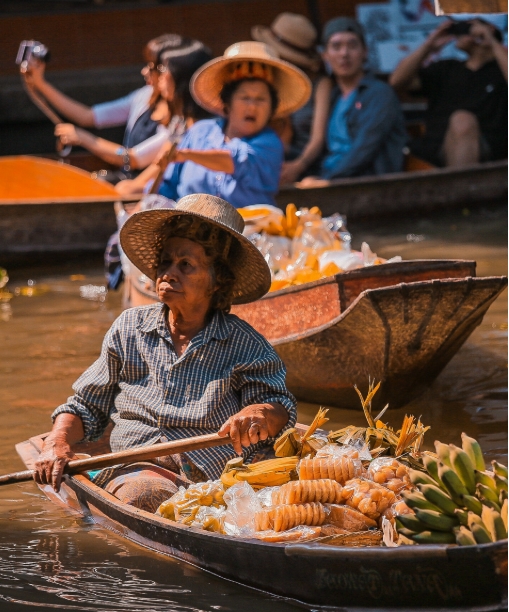
Street cuisine from Amphawa is well-known, especially shellfish. Vendors offering everything from Thai-style coconut pancakes to grilled prawns and fish can be found as you meander around the canals. Since locals visit the market, it’s also an excellent spot to get a look at local life.
Usually from Friday to Sunday, Amphawa runs in the afternoons and nights and is the ideal weekend get-away.
Chan Floating Market Taling
Taling Chan is the best option for anyone who would like a more relaxed, subdued experience. Taling Chan is much smaller and less packed than Damnoen Saduak and Amphawa, about 12 kilometers from downtown Bangkok, hence providing a more serene market environment.
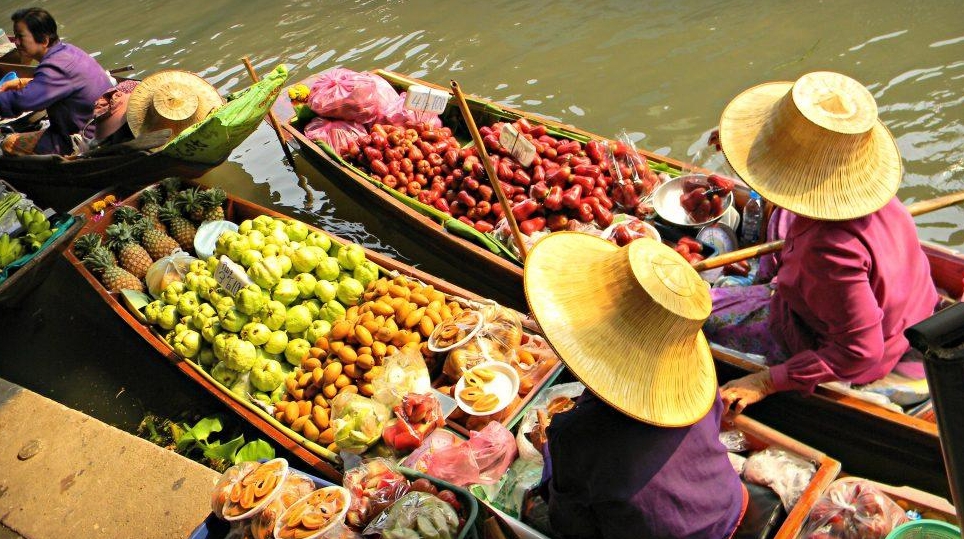
Boats offering traditional Thai cuisine like grilled fish and Thai-style curries as well as fresh vegetables and local delicacies are found here. With local boat trips and live music events, the market is also well-known for its energetic scene.
If you want to visit a more peaceful floating market, Taling Chan is open every Saturday and Sunday, hence it’s a fantastic alternative for a weekend trip.
How would one reach the floating market from Bangkok?
Knowing which floating market you should visit today will help you to plan how to get there. From downtown Bangkok, visiting a floating market is somewhat easy; yet, understanding your alternatives will save time and save needless trouble.
By either a taxi or a private car
By taxi or private automobile, you will go to any floating market fastest and most conveniently. Depending on traffic, a cab journey to Damnoen Saduak will take 1.5 to 2 hours if you are staying in downtown Bangkok. Likewise, Taling Chan just takes 30 to 45 minutes whereas Amphawa may be reached in around 1.5 hours.

Although using a cab costs more than using public transportation, it provides immediate access and comfort. Bangkok has a lot of taxis, and many of the drivers know the paths to the floating markets.
Cost projection:
Damnoen Saduak: Between 1,000, 1,500 THB.
Amphawa: Between 800 and 1,200 THB.
Taling Chan: 200–400 THB.
Remember that rates could change, particularly during busy times or if you are going around holidays.
By public transportation
Public transportation is a more affordable choice for frugal visitors even if it may require some more time and effort.

To Dimnoen Saduak:
From Bangkok’s Southern Bus Terminal (Sai Tai Mai), board a bus running to Ratchabudi or Damnoen Saduak. The bus trip lasts two hours or so.
Alternatively, you may ride a train from the Hua Lamphong Station in Bangkok to the closest station, say Ratchabiri, then change to a cab or tuk-tuk.
From Amphawa:
Direct buses to Amphawa from Bangkok’s Southern Bus Terminal take around 1.5 hours.
About Taling Chan:
Of the three marketplaces, Taling Chan comes closest to Bangkok. From Bangkok’s Mo Chit BTS Station, a bus or cab will get you to the market in thirty to forty-five minutes.
By Travel Package
Booking a floating market tour package could help you to have a hassle-free experience. Usually including round-trip transportation, a guided boat cruise, and visits to many floating marketplaces, these excursions Most trips pick you up from your hotel, so you have less concern about travel planning.
Depending on the time you choose to spend investigating the markets, half-day and full-day trips are offered under tour packages. Tour package prices often run from 800 to 2,000 THB per person.
Advice for Travelers visiting Bangkok Floating Markets
One of a kind experience is visiting a Bangkok floating market. To maximize your trip, however, there are a few pointers and strategies that will enable you to negotiate the busy rivers, steer clear of popular tourist traps, and really enjoy your stay in these unusual marketplaces. Here’s a useful manual on how to have the greatest time visiting a Bangkok floating market.
Show up early for the greatest experience.
Timing is one of the most crucial considerations when visiting a Bangkok floating market. Particularly the more well-liked marketplaces like Damnoen Saduak, they may get packed. Arriving early—probably about 6:00 or 7:00 AM—helps you to savor a more laid-back and real experience.
Arriving early allows you to enjoy the market before it becomes crowded with visitors. You will also have more chances to purchase the greatest assortment of products, snap pictures free from big crowds, and engage with neighborhood businesses. Arriving at the crack of dawn, for instance, at Damnoen Saduak allows you to savor the market at its busiest but most beautiful stage—before the visitor busses arrive.
Choose Respectful and Comfortable Clothing
Often a site of communal life and local business, Bangkok floating markets reflect this. Therefore, dressing correctly is crucial. Comfort is essential as you will probably stroll around a lot and, sometimes, ride a boat. Particularly if you want to remain in Bangkok for a few hours, lightweight, airy clothing is perfect for the hot and muggy conditions.
If you want to embark on a boat trip, it’s also advisable to pack flat shoes or sandals you might quickly slip off before boarding the boat. Remember sunscreen; a cap or sunglasses will shield you from the intense sun.
Furthermore, as the floating markets are culturally important, it is usually advisable to dress modestly in regard for the local merchants and traditions. This means avoiding very exposing attire, particularly while visiting historic marketplaces like Amphawa or Taling Chan.
Bring Cash and Use Reasonably
Although some suppliers may take credit cards, many of the smaller ones still want cash. Bringing enough Thai baht will let you to buy meals, souvenirs, or little goods straight from the boats. Usually not accepted by vendors, US dollars should be exchanged before you visit the market or one of the surrounding currency exchange facilities.
Bargaining in a Bangkok floating market is part of the pleasure; you should not hesitate! Although pricing are less flexible than they would be at street markets, a courteous offer of a reduced price may nevertheless result in reductions, particularly if you are purchasing in bulk or show actual interest in their items. Just keep it courteous and pleasant.
Get Ready for a Boat Ride.
Visiting a Bangkok floating market is about going on the river and observing the market from the vendor’s point of view, not just about meandering about the banks. Most floating markets include boat trips allowing you to explore the canals and do direct shopping from the boats.
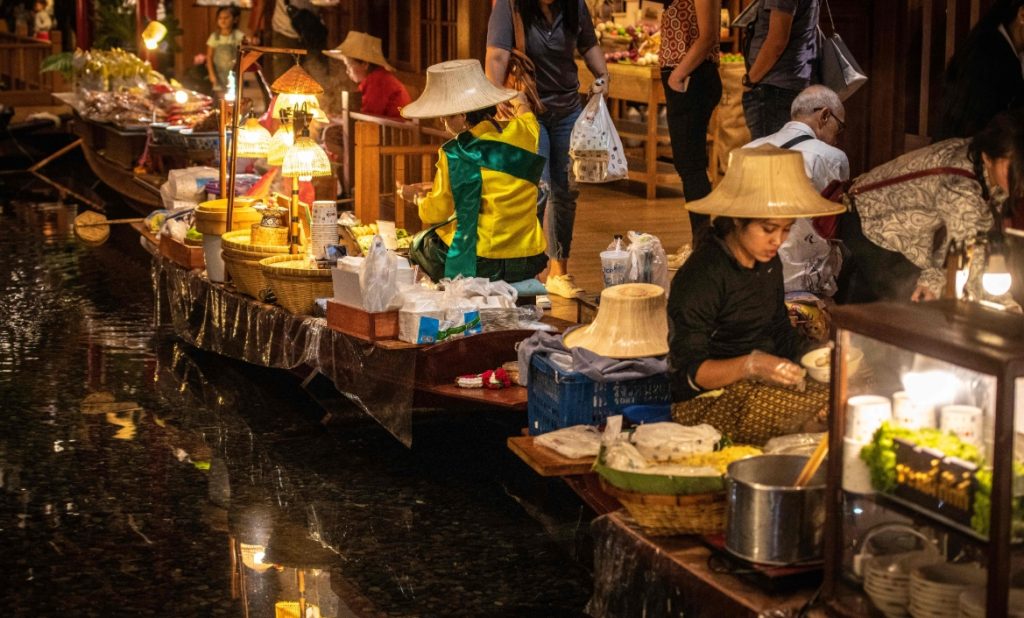
Although a boat trip gives the experience more joy and adventure, it’s also crucial to be aware of the waterways and the weather. While boat traffic is under control, safety always comes first even if some of the canals may become somewhat crowded. Pay close attention to the boat operators as they will walk you through the required safety precautions—like donning a life jacket.
A long-tail boat trip, in which you lay back and enjoy the breathtaking sights as your boatman leads you around the meandering canals, may be sought for an even more real experience.
Think About the surroundings.
You could see a lot of plastic packaging, trash in the water, and abandoned goods when browsing a Bangkok floating market. Though it might be daunting, it’s important to keep awareness of surroundings. Travelers may help by choosing reusable water bottles, cutting out needless waste, and appreciating local efforts at area cleanliness. Consider your trash and aim to leave the market looking just as lovely as you found it.
What should a visitor purchase at Bangkok Floating Markets—a shopping paradise?
The shopping in a Bangkok floating market is among the most fascinating aspects of a visit. Shopping here is a different experience because to the lively market environment, varied range of items, and pleasant boat merchants. From fresh food to handcrafted goods, here’s what you should most certainly purchase at a Bangkok floating market.
Fresh Thai Fruits
The amazing range of fresh fruits is one of the primary draws at any Bangkok floating market. Stacked high with tropical fruits like luscious mangoes, sweet pineapples, coconuts, and rambutan—a spiky, crimson fruit with sweet, juicy flesh—the vibrant boats Exotic fruits like durian or mangosteen—which you may not be acquainted with—can also be tasted.
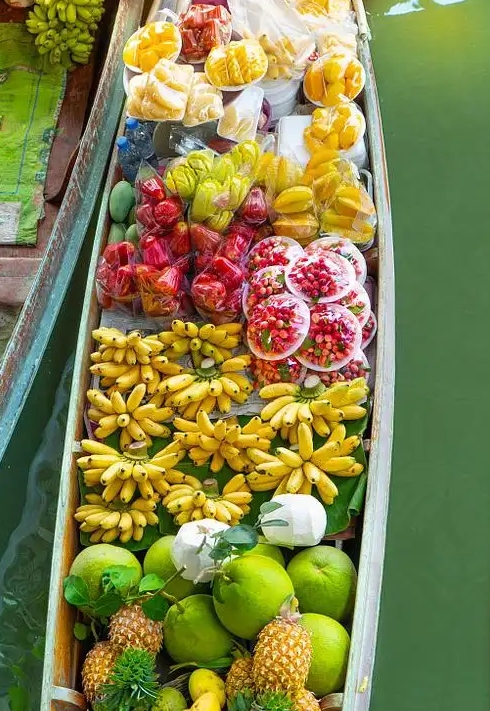
Ask the seller how much each kilogramme of most fruits costs as most of them are sold by weight. Purchasing fresh fruit from the market is not only a delicious delight but also a fantastic chance to sample real Thai food that you may not be able to get at your neighbourhood grocery.
Street Food and Traditionally Thai Snacks
Missing the street cuisine at a Bangkok floating market will not be something you desire. Many sellers prepare Thai delicacies directly on their boats, so you may easily get a bite to eat while shopping. Popular street cuisine worth sampling are:
Rich broth accompanied with noodles, meat, and seasonings in a bowl is boat noodles. Ideal for those want to sample real Thai tastes.
Fresh prawns, squid, and fish cooked to excellence are presented with hot dipping sauces.
Usually presented with sugar, condensed milk, or fruit, roti is a crispy, thin pancake.
These are just a few of the many snacks and sweets on hand, each with unique tastes likely to pique your interest. Keep in mind to include cash for your meals and beverages.
Handcrafted Objects and Memorabilia
Apart from cuisine, Bangkok floating markets provide a wealth of local handicaps. Many stores offer handcrafted jewelry, fabrics, and little mementos. Popular objects include hand-carved wooden figures, traditional Thai silk scarves, and complex baskets. These handcrafted items are ideal for anybody seeking something distinctive to bring home.
Perfect for accentuating a little Thai flair to your house décor, you may also locate a variety of ornamental objects such wooden elephants, little Buddha sculptures, or Thai-style lanterns.
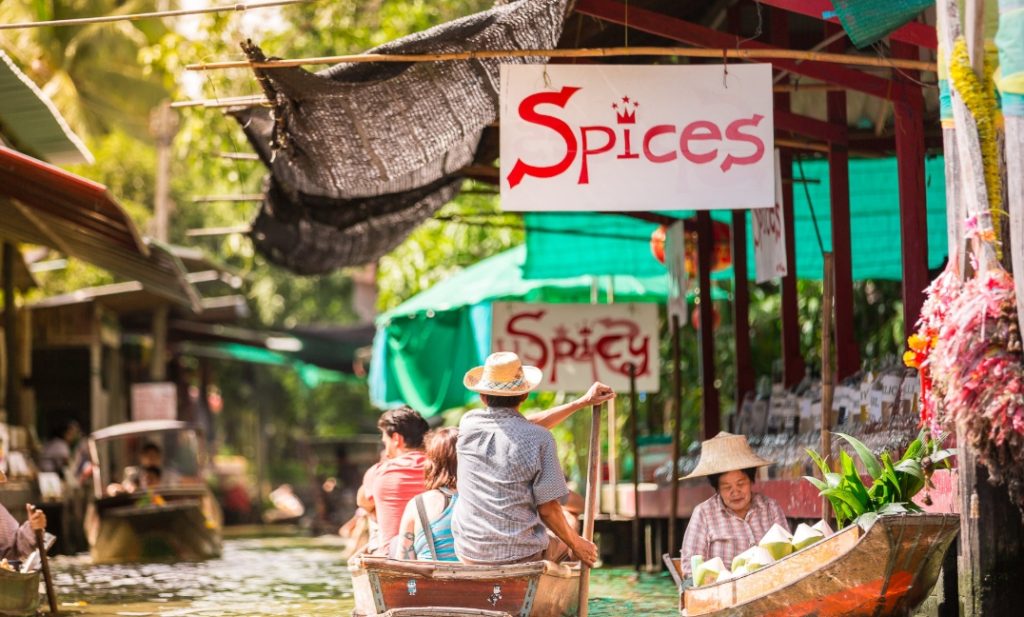
Thai Herbs and Remedies
Many floating markets provide a variety of health and beauty items created from natural Thai herbs in addition to food and handcrafted goods. These cover soaps, lotions, oils, and herbal teas. This is the spot to go if you want to pick up a distinctive beauty product or are interested in local treatments.
Certain markets, such Amphawa, are well-known for offering herbal cures for conditions including skin irritations or headaches used by the residents. If you’re looking for something natural and useful, they are a fantastic keepsie.
Local Accessory and Clothing
From casual tees to traditional Thai gowns, you may also discover a range of clothes in Bangkok floating market. Many of the clothing are handwoven or created from locally sourced materials, so they are real and somewhat unique from what you will find in the stores.
Additionally you will find traditional Thai-style accessories like shoes, backpacks, and caps. Look for these objects, which would make wonderful presents or souvenirs, if you’re seeking for something interesting and different to wear.
Visiting a Bangkok floating market offers a chance to enter a live work of Thai history and culture rather than just a place to buy and dine. From the vibrant boats to the busy booths, every floating market offers something unique for visitors wishing to see the real side of Bangkok.
Plan ahead, be early, and spend some time really appreciating the event. A Bangkok floating market will surely be among the most unforgettable aspects of your vacation to Thailand, whether your interests are in souvenirs, great Thai cuisine, or just ambiance.


